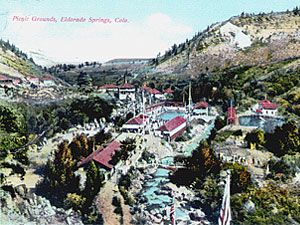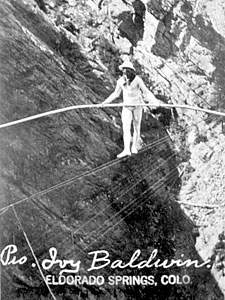Before European Settlement
The Ute Native American tribes who lived in the mountains of Colorado and Utah frequented Eldorado Canyon, savoring the warm springs for health and spiritual renewal. A few arrowheads and artifacts remain, as most were removed before Eldorado Canyon became a State Park. In Spanish, the words “el dorado” mean gilded or covered with gold, which may refer to the golden color of the lichen on the cliffs.
European Settlement
By the mid-1800s the Utes had lost most of eastern Colorado to settlers. In 1858, John Doudy was the first to homestead along South Boulder Creek. Others soon followed: John DeBacker, Jonas and Vira Ann Barber, John Dunn, and the Pruden family. Vira Ann Barber brought black walnuts with her, carrying them in her shoes, and planted them in the area. Some of her trees still bear fruit today. These pioneers established ranches and farms, small businesses, sawmills and logging operations near Eldorado Canyon.
In the 1880s Phillip Kneale and his two brothers were the first homesteaders within the canyon itself. He ran a sawmill one mile west of the present State Park and built a home in 1912 that is still occupied by his descendants. Kneale built a boarding house adjacent to the mill for his logging crews. Horse-drawn wagons carried lumber out of the canyon entry along a road which had been built as a grade for a narrow-gauge railroad in the 1890s. The railroad was a failed venture of the Colorado Southern and Pacific - no track was ever laid; this is the current day "Fowler Trail."
The Golden Era

The turn of the century ushered in a new era for the canyon. In 1902 the federal government granted Union Pacific land in the area to construct a railroad. The "Moffat Road" rail line still operates today along the southern flank of the canyon as the Denver & Rio Grande route from Denver west to Winter Park and beyond.
In 1904 spiritualist George Taylor's group bought 480 acres of the canyon from the Union Pacific railroad. Later that year, Frank Fowler, a young entrepreneur, purchased the property with his partners from Taylor for $5000.
During its heyday the resort boasted two hotels (the Grandview and New Eldorado), three swimming pools, two dance ballrooms, roller- and ice-skating rinks, cabins, stables and many other amenities. The Eldorado Springs Resort attracted many celebrities, including the young Dwight and Mamie Eisenhower who honeymooned in one of the cabins in 1916.
Starting in 1908, the Interurban railway made nine trips a day from Marshall to Eldorado Springs, bringing thousands to enjoy the "Coney Island of the West." The $l.25 round-trip fare included entry into the resort for swimming, dancing, hiking and other recreation. By 1907 cars packed the parking lots daily, carrying about 40,000 people a day to the resort.

In 1907 aerialist Ivy Baldwin became another major attraction. He moved to Eldorado after an adventurous life as a high wire acrobat, balloonist and parachutist. He performed in the circus for many years, including a show for the Emperor of Japan, and he served in the Spanish-American War as a parachute specialist performing reconnaissance work. Thousands of people gathered on weekends and holidays to watch Ivy Baldwin walk across a 7/8-inch thick, steel cable stretched from the top of Castle Rock (the Bastille) to the Wind Tower, 672 feet across and over 400 feet above South Boulder Creek. Ivy Baldwin took six and a half minutes to walk to the middle of the stretched cable, bow, and then stand on his head, before continuing to the opposite side, the entire time without a safety net. In 1948 this incredible man celebrated his 82nd birthday by walking the wire one last time.
The New Eldorado Hotel was built in 1908 as a luxury spot; it sat grandly above one of the swimming pools and the dance hall. The hotel offered forty rooms and was an excellent example of the nineteenth century Georgian style architecture.
At this time, the most popular hike was to "Harmon Falls." In 1908 Frank Fowler built the "Crazy Stairs" which were two flights of zigzagging wooden stairs climbing nearly 600 feet, just east of Castle Rock (the Bastille).
Rock Climbing Begins and the creation of a State Park
The first climbers came to the canyon in the 1950s. The first groups of technical climbers were called”marmots," after the rock-dwelling mammals. For a brief period in the 1960s, the canyon became a private club. A few years later, the resort again re-opened to the public, once again offering family-oriented recreation opportunities.
The canyon’s owner threatened to sell the area for a rock quarry, but public outcry at the prospect prompted the State of Colorado to purchase the canyon in 1978 and create Eldorado Canyon State Park. The Park has preserved the natural splendor of the area and fostered the continued enjoyment by the public.
Although Eldorado Canyon has passed through many changes and attracted many thousands of visitors, its rugged beauty, unique resources, and healing atmosphere have always inspired a special love and respect.
We are happy to be able to share Eldorado Canyon’s colorful past, and we hope you will join with us to preserve Eldorado Canyon for generations to come.

